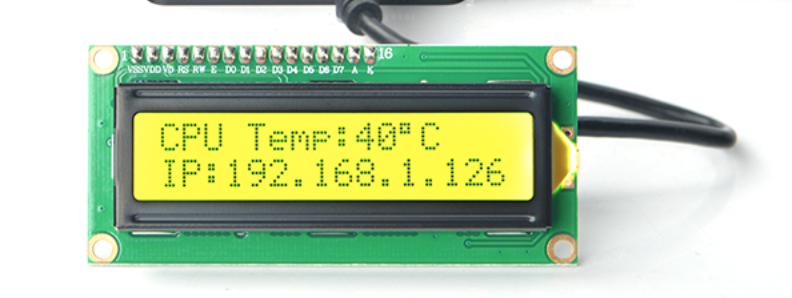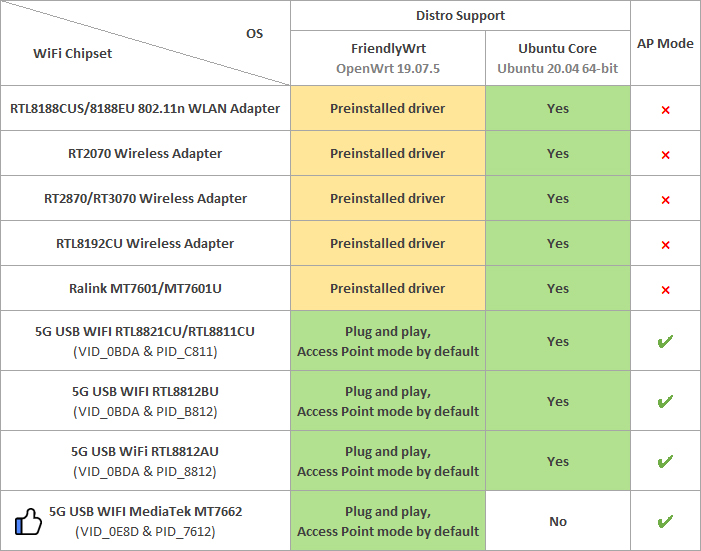Difference between revisions of "Template:FriendlyWrt21"
(updated by API) |
(updated by API) |
||
| Line 246: | Line 246: | ||
</syntaxhighlight> | </syntaxhighlight> | ||
--> | --> | ||
| + | {{#switch: {{{1}}} | ||
| + | | NanoPi-R2S | ||
| + | | NanoPi-R2C-Plus | ||
| + | | NanoPi-R2C = | ||
| + | ===挂载外接存储设备=== | ||
| + | (1) 把移动硬盘连接{{{1}}}作为外接存储设备,将移动硬盘插入{{{1}}}的USB接口,在FriendlyWrt中点击“系统->挂载点”进入挂载点设置界面:<br /> | ||
| + | [[File:R2s-wrt-jellyfin-006.jpg|frameless|800px]]<br /> | ||
| + | (2) 在界面下方找到挂载点存储设备设置,点击“添加”按钮:<br /> | ||
| + | [[File:R2s-wrt-jellyfin-007.jpg|frameless|800px]]<br /> | ||
| + | (3) 在弹出的对话框中UUID一栏选中刚刚接入的移动硬盘 /dev/sda1(实际情况请根据自身设备选择,如硬盘有多个分区可能会显示sda1/sda2……等):<br /> | ||
| + | [[File:R2s-wrt-jellyfin-008.jpg|frameless|800px]]<br /> | ||
| + | (4) 在挂载点一栏中使用自定义,填入要挂载到的目标目录,这里以/jellyfin/videos 目录为例,勾选上方的“已启用”,然后点击“保存”:<br /> | ||
| + | [[File:R2s-wrt-jellyfin-009.jpg|frameless|800px]]<br /> | ||
| + | [[File:R2s-wrt-jellyfin-010.jpg|frameless|800px]]<br /> | ||
| + | (5) 设置完后点击“系统->重启”重启{{{1}}}使挂载点生效:<br /> | ||
| + | [[File:R2s-wrt-jellyfin-011.jpg|frameless|800px]]<br /> | ||
| + | (6) 重启后再回到“挂载点”界面可看到“已挂载的文件系统”中显示刚刚挂载的移动硬盘信息,即设置成功(以后需要再新增或删减编辑挂载点都可以在下面的“挂载点”设置中操作):<br /> | ||
| + | '''注:每次操作后都需要重启后才能生效'''<br /> | ||
| + | [[File:R2s-wrt-jellyfin-012.jpg|frameless|800px]]<br /> | ||
| + | | #default = | ||
| + | }} | ||
| + | ====使用外接硬盘来扩展Docker可用空间==== | ||
| + | TODO | ||
| + | ====Docker的常见问题与解决办法==== | ||
| + | * 无法访问Docker提供的网络服务 | ||
| + | 解决办法: <br /> | ||
| + | a) 进入 "防火墙" 的设置,把 "转发" 设置成 "接受"; <br /> | ||
| + | b) 关闭 ”软件流量分载“; <br /> | ||
| + | <br /> | ||
===Mount smbfs=== | ===Mount smbfs=== | ||
<syntaxhighlight lang="bash"> | <syntaxhighlight lang="bash"> | ||
Revision as of 08:20, 22 June 2022
Contents
- 1 Work with FriendlyWrt
- 1.1 Introduction to FriendlyWrt
- 1.2 First boot
- 1.3 Account & Password
- 1.4 Login FriendlyWrt
- 1.5 Recommended security settings
- 1.6 Safe shutdown operation
- 1.7 Soft Factory Reset
- 1.8 Install Software Packages
- 1.9 Disable IPv6
- 1.10 Configure the function of the user button
- 1.11 Some common issues of FriendlyWrt
- 1.12 Use USB2LCD to view IP and temperature
- 1.13 Work with USB WiFi Device
- 1.14 Work with Docker Applications
- 1.15 Mount smbfs
- 1.16 Use sdk to compile the package
1 Work with FriendlyWrt
1.1 Introduction to FriendlyWrt
FriendlyWrt is a customized system made by FriendlyElec based on an OpenWrt distribution. It is open source and well suitable for developing IoT applications, NAS applications etc.
1.2 First boot
For the first boot, the system needs to do the following initialization work:
1)Extended root file system
2)Initial setup(will execute /root/setup.sh)
So you need to wait for a while (about 2~3 minutes) to boot up for the first time, and then set FriendlyWrt, you can enter the ttyd terminal on the openwrt webpage, when the prompt is displayed as root@FriendlyWrt, it means the system has been initialized.
root@FriendlyWrt
1.3 Account & Password
The default password is password (empty password in some versions). Please set or change a safer password for web login and ssh login. It is recommended to complete this setting before connecting {{{1}}} to the Internet.
1.4 Login FriendlyWrt
Connect the PC to the LAN port of {{{1}}}. If your PC without a built-in ethernet port, connect the LAN port of the wireless AP to the LAN port of {{{1}}}, and then connect your PC to the wireless AP via WiFi , Enter the following URL on your PC's browser to access the admin page:
- http://friendlywrt/
- http://192.168.2.1/
- http://[fd00:ab:cd::1]
The above is the LAN port address of {{{1}}}. The IP address of the WAN port will be dynamically obtained from your main router through DHCP.
1.5 Recommended security settings
The following settings are highly recommended to complete before connecting {{{1}}} to the Internet。
- Set a secure password
- Only allow access to ssh from lan, change the port
- Only allow local devices to access luci
Edit /etc/config/uhttpd,Change the original 0.0.0.0 and [::] addresses to the local lan address, for example:
# HTTP listen addresses, multiple allowed list listen_http 192.168.2.1:80 list listen_http [fd00:ab:cd::1]:80 # HTTPS listen addresses, multiple allowed list listen_https 192.168.2.1:443 list listen_https [fd00:ab:cd::1]:443
Restart the service:
/etc/init.d/uhttpd restart
- Check the firewall settings
Set up as you wish.
1.6 Safe shutdown operation
Enter the "Services" -> "Terminal", enter the "poweroff" command and hit enter, wait until the led light is off, and then unplug the power supply.
1.7 Soft Factory Reset
Enter "System"->"Backup/Flash firmware",Click “Perform reset“ Button, Your device's settings will be reset to defaults like when FriendlyWrt was first installed.
You can also do this in the terminal:
firstboot && reboot1.8 Install Software Packages
1.8.1 Update Package List
Before install software packages update the package list:
$ opkg update
1.8.2 List Available Packages
$ opkg list
1.8.3 List Installed Packages
$ opkg list-installed
1.8.4 Install Packages
$ opkg install <package names>
1.8.5 Remove Packages
$ opkg remove <package names>
1.9 Disable IPv6
. /root/setup.sh disable_ipv6 reboot
1.10 Configure the function of the user button
By default, the user button is configured to reboot the device, as shown below:
echo 'BTN_1 1 /sbin/reboot' >> /etc/triggerhappy/triggers.d/example.conf
You can change its behavior by changing the configuration file above.
1.11 Some common issues of FriendlyWrt
- Unable to dial up
- Go to "Network" -> "Firewall" and set "Inbound Data", "Outbound Data" and "Forwarding" in "WAN Zone" to "Accept";
- If you still cannot access the Internet, you can try to turn off IPV6;
- Dial-up successful, but no outgoing traffic
- Go to "Services" -> "Terminal" and type "fw4 reload" to try to reload the firewall settings again;
- Unable to power on
- Try to replace the power adapter and cable. It is recommended to use a power supply with specifications above 5V/2A;
- Note that some fast chargers with Type-C interface will have a delay, it may take a few seconds to start providing power;
- When doing secondary routing, the computer cannot connect to the Internet
- If your main network is IPv4, and {{{1}}} works in IPv6, the computer may not be able to connect to the Internet. It is recommended to turn off IPv6 (the method is described later in this WiKi), or switch the main route to IPv6;
- If you have questions or have better suggestions, please send an email to techsupport@friendlyarm.com;
1.12 Use USB2LCD to view IP and temperature
Plug the USB2LCD module to the USB interface of{{{1}}} and power on, the IP address and CPU temperature will be displayed on the LCD:

1.13 Work with USB WiFi Device
1.13.1 Check USB WiFi Device with Command Line Utility
(1) Click on "services>ttyd" to start the command line utility
(2) Make sure no USB devices are connected to your board and run the following command to check if any USB devices are connected or not
lsusb
(3) Connect a USB WiFi device to the board and run the command again
lsusb
You will see a new device is detected. In our test the device's ID was 0BDA:C811
(4) Type your device's ID (in our case it was "0BDA:C811" or "VID_0BDA&PID_C811") in a search engine and you may find a device that matches the ID. In our case the device we got was Realtek 8811CU.
1.13.2 Configure a USB WiFi Device as AP
(1) Connect a USB WiFi device to the {{{1}}}. We recommend you to use the following devices:

Note: devices that match these VID&PIDs would most likely work.
(2) Click on "System>Reboot" and reboot your {{{1}}}
(3) Click on "Network>Wireless" to enter the WiFi configuration page
(4) Click on "Edit" to edit the configuration
(5) On the "Interface Configuration" page you can set the WiFi mode and SSID, and then go to "Wireless Security" to change the password. By default the password is "password". After you make your changes click on "Save" to save
(6) After you change the settings you can use a smartphone or PC to search for WiFi
1.13.3 Common USB WiFi issues
1) It is recommended to plug in the usb wifi in the off state, then power it on, FriendlyWrt will automatically generate the configuration file /etc/config/wireless, if not, see if there is wlan0 by ifconfig -a, if there is no wlan0, usually there is no driver.
2) If ifconfig -a sees wlan0, but the hotspot is not working properly, try changing the channel and country code, an inappropriate country code can also cause the WiFi to not work.
3) Some USB WiFis (e.g. MTK MT7662) work in CD-ROM mode by default and need to be switched by usb_modeswitch, you can try to add usb_modeswitch configuration to the following directory: /etc/usb_modeswitch.d.
1.13.4 Change the default WiFi hotspot configuration
FriendlyWrt sets the country, hotspot name and other parameters for USB WiFi by default, with the aim of being as plug-and-play as possible, but this does not guarantee that all modules will be compatible with this setting, you can change these behaviors by modifying the following file:
/lib/wifi/mac80211.sh
1.14 Work with Docker Applications
1.14.1 Work with Docker: Install JellyFin
mkdir -p /jellyfin/config mkdir -p /jellyfin/videos docker run --restart=always -d -p 8096:8096 -v /jellyfin/config:/config -v /jellyfin/videos:/videos jellyfin/jellyfin:10.1.0-arm64 -name myjellyfin
After installation, visit port 8096 and here is what you would find:

1.14.2 Work with Docker: Install Personal Nextcloud
mkdir /nextcloud -p docker run -d -p 8888:80 --name nextcloud -v /nextcloud/:/var/www/html/ --restart=always --privileged=true arm64v8/nextcloud
After installtion, visit port 8888.
1.14.3 使用外接硬盘来扩展Docker可用空间
TODO
1.14.4 Docker的常见问题与解决办法
- 无法访问Docker提供的网络服务
解决办法:
a) 进入 "防火墙" 的设置,把 "转发" 设置成 "接受";
b) 关闭 ”软件流量分载“;
1.15 Mount smbfs
mount -t cifs //192.168.1.10/shared /movie -o username=xxx,password=yyy,file_mode=0644
1.16 Use sdk to compile the package
1.16.1 Install the compilation environment
Download and run the following script on 64-bit Ubuntu (version 18.04+): How to setup the Compiling Environment on Ubuntu bionic
1.16.2 Download and decompress sdk from the network disk
The sdk is located in the toolchain directory of the network disk:
tar xvf openwrt-sdk-*-rockchip-armv8_gcc-11.2.0_musl.Linux-x86_64.tar.xz # If the path is too long, it will cause some package compilation errors, so change the directory name here mv openwrt-sdk-*-rockchip-armv8_gcc-11.2.0_musl.Linux-x86_64 sdk cd sdk ./scripts/feeds update -a ./scripts/feeds install -a
1.16.3 Compile the package
download the source code of the example (a total of 3 examples are example1, example2, example3), and copy to the package directory:
git clone https://github.com/mwarning/openwrt-examples.git cp -rf openwrt-examples/example* package/ rm -rf openwrt-examples/
Then enter the configuration menu through the following command:
make menuconfigIn the menu, select the following packages we want to compile (actually selected by default):
"Utilities" => "example1" "Utilities" => "example3" "Network" => "VPN" => "example2"
execute the following commands to compile the three software packages:
make package/example1/compile V=99 make package/example2/compile V=99 make package/example3/compile V=99
After the compilation is successful, you can find the ipk file in the bin directory, as shown below:
$ find ./bin -name example*.ipk ./bin/packages/aarch64_generic/base/example3_1.0.0-220420.38257_aarch64_generic.ipk ./bin/packages/aarch64_generic/base/example1_1.0.0-220420.38257_aarch64_generic.ipk ./bin/packages/aarch64_generic/base/example2_1.0.0-220420.38257_aarch64_generic.ipk
1.16.4 Install the ipk to NanoPi
You can use the scp command to upload the ipk file to NanoPi:
cd ./bin/packages/aarch64_generic/base/ scp example*.ipk root@192.168.2.1:/root/
Then use the opkg command to install them:
cd /root/ opkg install example3_1.0.0-220420.38257_aarch64_generic.ipk opkg install example1_1.0.0-220420.38257_aarch64_generic.ipk opkg install example2_1.0.0-220420.38257_aarch64_generic.ipk